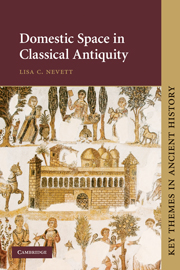Book contents
- Frontmatter
- Contents
- List of figures
- List of plates
- Preface and acknowledgements
- Map showing the locations of the sites and regions discussed in Chapters 3–6
- Introduction
- 1 Domestic space and social organisation
- 2 House-form and social complexity: the transformation of Early Iron Age Greece
- 3 A space for ‘hurling the furniture’? Architecture and the development of Greek domestic symposia
- 4 Housing and cultural identity: Delos, between Greece and Rome
- 5 Seeking the domus behind the dominus in Roman Pompeii: artefact distributions as evidence for the various social groups
- 6 Housing as symbol: elite self-presentation in North Africa under Roman rule
- Epilogue: domestic space and social organisation in Classical Antiquity
- Glossary
- Period names and dates referred to in this book
- Bibliographic essay
- Bibliography
- Index
3 - A space for ‘hurling the furniture’? Architecture and the development of Greek domestic symposia
Published online by Cambridge University Press: 05 August 2012
- Frontmatter
- Contents
- List of figures
- List of plates
- Preface and acknowledgements
- Map showing the locations of the sites and regions discussed in Chapters 3–6
- Introduction
- 1 Domestic space and social organisation
- 2 House-form and social complexity: the transformation of Early Iron Age Greece
- 3 A space for ‘hurling the furniture’? Architecture and the development of Greek domestic symposia
- 4 Housing and cultural identity: Delos, between Greece and Rome
- 5 Seeking the domus behind the dominus in Roman Pompeii: artefact distributions as evidence for the various social groups
- 6 Housing as symbol: elite self-presentation in North Africa under Roman rule
- Epilogue: domestic space and social organisation in Classical Antiquity
- Glossary
- Period names and dates referred to in this book
- Bibliographic essay
- Bibliography
- Index
Summary
I only mix three rounds of wine for moderate men – one for health, which they drink first, a second one for love and enjoyment, and a third for sleep. Sensible visitors go home when this one is finished. The fourth round is out of control and is ruled by violence; the fifth one by commotion, the sixth by drunken rowdiness, the seventh one leads to black eyes. The eighth round belongs to the police, the ninth to nausea, and the tenth to craziness and hurling the furniture.
Euboulus, quoted in Athenaeus, Deipnosophistae 2.36bHow space, time and people are organized is not random. The organization interrelates with deeper concepts of social values concerning gender relations, age relations and other forms of status relations, as well as more abstract values such as beliefs about privacy and community…
Pader 1997, 72INTRODUCTION
In Chapter 2 I suggested that the close association between the scale and layout of a house and the complexity of the society to which its inhabitants belonged offers a new perspective through which to explore the formation of the Greek polis or citizen-state. This chapter focuses on the development of one of the social institutions which were instrumental in structuring relationships within the polis, namely the symposium or drinking party (Small 1997, 113). Discussion of the symposium has tended to focus on ancient texts and on painted pottery which appears to show such occasions in progress, but, although it is assumed that they were frequently held in private houses and that the architectural setting played an important role in shaping the atmosphere, little attention has been paid to the archaeological evidence of housing as a source for understanding sympotic behaviour.
- Type
- Chapter
- Information
- Domestic Space in Classical Antiquity , pp. 43 - 62Publisher: Cambridge University PressPrint publication year: 2010



